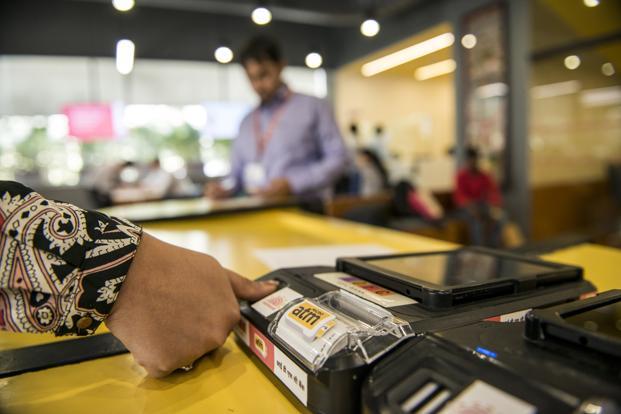
An Aadhaar-enabled payment system will be launched soon, finance minister Arun Jaitley announced in his Budget speech for the financial year (FY) 2017-18. Aadhar Pay is the merchant version of Aadhaar-enabled payment system. The Aadhaar Pay app lets consumers pay without any physical payment instrument. It runs on the Android platform and has to be installed by merchants.
To use it, merchants need to first download the Aadhaar Pay app and then register to start using it. After registration, the merchant’s mobile phone needs to be linked to an Aadhaar biometric reader. Once the merchant has this infrastructure in place, the consumers can start transacting. To make a payment, the consumer has to just enter her Aadhaar number. The fingerprint is the password for the transaction. To use this service, the customer has to first link her bank account to her Aadhaar. Jaitley said that Aadhaar Pay will be specifically beneficial for those who do not have debit cards, mobile wallets and mobile phones. However, the consumer needs to have a bank account and Aadhaar number. “The launch of Aadhaar Pay for people without mobile phones will spearhead the country’s transition to digital economy,” said Neel Ratan, leader- government and public sector, PwC India. In January, law and information technology minister Ravi Shankar Prasad had said that more than 14 banks had been integrated with Aadhaar Pay and 1.11 billion people had an Aadhaar number. The government is banking on this infrastructure to build Aadhaar Pay. As of now, you can make electronic payments to offline merchant using cards, e-wallets and the Unified Payment Interface (UPI).
In case of online merchants, you could do it using Net banking as well. For card transactions, a merchant needs to install PoS machines, which cost between Rs5,000 and Rs15,000. The consumer needs to have a credit or debit card to do the transaction. For card transactions, merchants have to pay a merchant discount rate in the range of 0.5-1% of the value of the transaction. If you are a consumer, you also incur the cost of holding the card—in the form of annual fee and joining fee, which usually start from Rs200. In case of e-wallets, the merchant transaction has not picked up pace because of interoperability issues. Therefore, both the merchant and the consumer need to have an e-wallet from the same service provider to complete the transaction. There are no charges for the consumer, however the merchant may have to pay a fee to the e-wallet service provider—which could start from 0.5% of the value of transaction. UPI, which was launched in August 2016, currently has over 35 member banks. To use this service, customers need to have a UPI-enabled app, a bank account and a registered mobile number. Besides these modes of payment, you can also pay using QR codes—a machine-readable matrix, which you can scan with your smartphone to pay. At present, various payment companies and banks provide different QR codes. The government sees potential in QR codes and is looking to provide a common QR code solution, which will be interoperable across payment networks. A common QR code will allow merchants to display a standard QR code, which can be linked to all the three payments networks—RuPay, MasterCard and Visa.
India is currently at a stage where it is building the road for electronic payments. Aadhaar Pay will be another channel to make payments. Compared with card payments, it will be cheaper.
